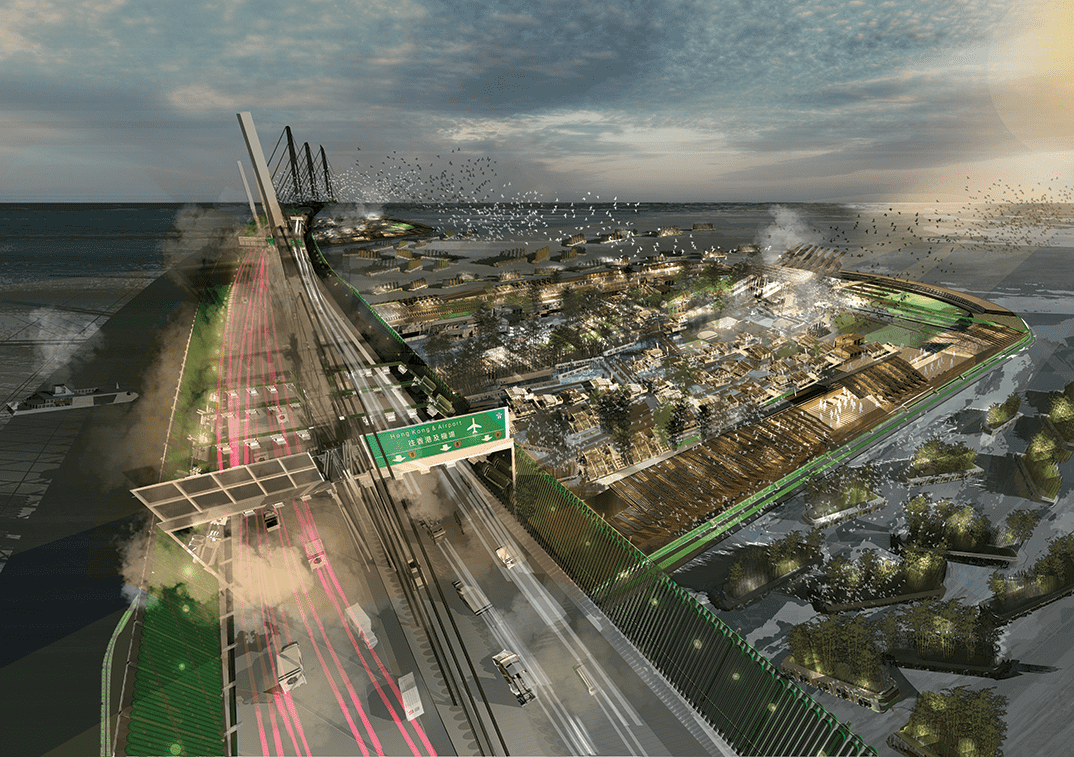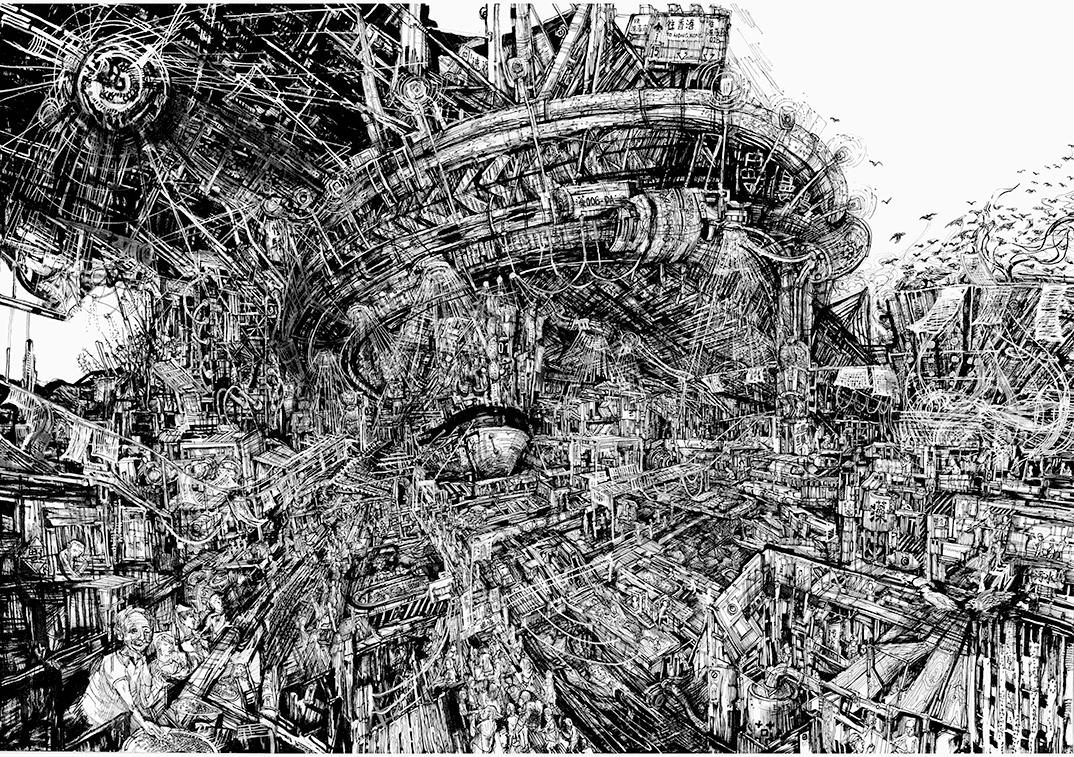Redefining Land Usage
In response to the immediate crisis of land shortage, the Hong Kong 2030+ Planning and Vision proposes 5030 hectares of land in the next two decades, 535 of which, equivalent to 28 Victoria Parks, will be created through land reclamation.
Although such development can efficiently produce large and flexible empty area, reclamation will damage the city’s frail ecosystem and biodiversity. While these reclamation proposals offer solutions through building on new landscape, possibilities to build upon existing artificial landscapes are to be explored.
Matrix Of Floating Villages And Waste-Canals
The Hong Kong-Zhuhai-Macau Bridge (HKZMB) offers two 150-hectare artificial islands to accommodate the needs of traffic facilities. While land reclamation becomes the seemingly obvious and efficient solution to create spaces, as inspired by the historical precedent of Tai-O, solutions that is more environmental sustainable and flexible yet sustainable in time is speculated. This will take advantage of its adjacent infrastructure to generate energy, attract visitors and minimize the impact of the bridge’s construction to the surrounding habitat.
Instead of building upon the reclaimed islands, the bridge’s foundation is utilised to anchor the new landscape. This regenerative offshore typology – deComposite, contains an organised matrix of floating villages and waste-canals, inspired by traditional water settlements of South East Asia. Its bolted pontoon system attaches to the mega-structure’s base, neutralising pollution with photosynthetic algal tubes along the highway. Residual alga is fed into aquaculture farming and wastewater treatment, where it is refined into bio-fuel and pumped into passing cars and cruise ships.
Located along the HKZMB with an offshore typology, deComposite takes inspiration from advantages of Tai-O’s urban fabric. With a population of 3000, Tai-O is a popular tourist destination, local community and cultural hub embodying Hong Kong’s traditions. Its historical significance was heavily based on supplying salt and fish for the mainland. In 1940, salt marshes were covering 70 acres (280,000 square metres) and that the production amounted to 25,000 piculs (1,512 metric tons) in 1938. Its vernacular production plants and organic architectural fabric created a distinct architectural character, which to this date has been off limits for commercial developments.
Similarly, deComposite is designed with matrices of village houses, featuring hidden alleyways, wide boulevards and small bridges that interwoven with fishing culture. It is reminiscent of Tai-O’s organic architectural characters, which residents are not confined by a modular system but can tailor their own living space. Its environmental condition also mirrors with historical Tai-O. The preserved ecosystem is integrated through the consumption of de-oxygenated algae, rehabilitating and nurturing locally endangered wildlife at the scheme’s central boulevard, specifically Germaine Swiftlets and Oysters. Protecting and farming the by-products of these culturally significant produces allows the village-port to be economically self-sustained.
Self-sustaining Construction Material
deComposite takes consideration of its offshore typology and minimises sources of pollution such as concrete construction by producing materials locally. Moso Bamboo is a key ingredient in the project. It is a self-sustaining construction material. Its tensile and fast growing property is ideal for maintenance on the villages’ componentry. These are harvested in floating bamboo ‘greenhouses’ envelope the network of plug-in amenities feeding into the anchor’s heart. The neighbouring hollowed container ships become pots to grow vegetation and crops, and re-use wastes sealed in biodegradable capsules as fertilisers. These designs create a regenerative typology that reduces carbon dioxide emission from transportation of resources. The only key concrete structure within the masterplan is a concrete ring of breakwater around its perimeter, which provides protection from incoming waves that can possibly harm village facilities.
Visions
The project is inspired to adapt Tai-O fishing village, a significant microcosm that embodies Hong Kong’s reliance on sea harvesting. This ambitious scheme hopes to reinvent Hong Kong to develop technological advantages in aquaculture farming, due to extreme scarcity of land. As each ‘colony’ node along the bridge is aimed to be economically self-sufficient, it is hoping that this proposal’s budget is realised by the government to increase the flow of cars to live or visit these floating retreats.
By daring to think of ‘beautifying waste’, it is hoping that the government would consider waste-managing with algae and other ecological alternatives, and be embedded into the development of future masterplans. This would create a living system on pontoons that reinvigorates the stigma associated to cumbersome floating living, especially with repair material (bamboo grown on ships) and feeding waste into a robust ecosystem.
Ultimately, It is envisioned that deComposite can act as a seed for coexisting farming, living and culture. It will propagate along future sea-megastructures, providing an autonomous framework for waste treatment in areas dependent on coastal networks. Aside from accommodating functional needs, the scheme also draws awareness towards human experiences and culture in projects of infrastructural scale. The scheme provokes a redefinition of land usage under the crisis of increasingly scarce buildable space, to develop upon distinctions of Hong Kong’s traditional living whilst synthesising innovative green technology.
PROJECT DATA
Student Names: Kachi Law; Justin Chow
School: UCL Bartlett School of Architecture, London
Project Name: Breathing Anchor
Location: Hong Kong- Zhuhai-Macau Bridge

 Malaysia
Malaysia Singapore
Singapore Indonesia
Indonesia Tiếng Việt
Tiếng Việt ประเทศไทย
ประเทศไทย













